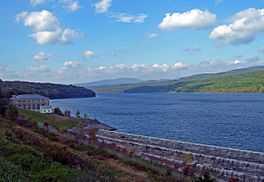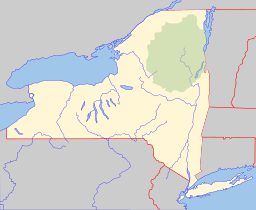Rondout Reservoir facts for kids
Quick facts for kids Rondout Reservoir |
|
|---|---|

Spillway at eastern end
|
|
| Location | Catskill Mountains, Ulster / Sullivan counties, New York, United States |
| Coordinates | 41°49′21.36″N 74°28′15.6″W / 41.8226000°N 74.471000°W |
| Type | reservoir |
| Primary inflows | Rondout Creek |
| Primary outflows | Delaware Aqueduct |
| Basin countries | United States |
| Max. length | 6.5 mi (9.7 km) |
| Surface area | 2,052 acres (830 ha) |
| Average depth | 73.8 ft (22.5 m) |
The Rondout Reservoir is a very important part of New York City's water supply. It's located about 75 miles (120 km) northwest of the city, up in the Catskill Mountains. This big lake is split between Ulster County and Sullivan County.
The Rondout Reservoir is like a main hub for the city's Delaware System. This system helps provide half of all the water New York City uses every day.
Contents
Building the Rondout Reservoir
The Rondout Reservoir was created by building a large structure called the Merriman Dam. This dam was built across the Rondout Creek. Construction started in 1937 and finished in 1954.
The reservoir began sending water to the city in 1951. It was the first of four reservoirs built by New York City after World War II. These new reservoirs were needed because the city was growing and needed more water.
When the reservoir was built, three small villages had to be moved. These villages were Lackawack, Montela, and Eureka. A small town called Grahamsville is still located just west of the reservoir.
Water Quality and Fish Safety
In 1998, the city's Department of Environmental Protection (DEP) gave a special warning. They suggested not eating more than one smallmouth bass per month caught from the reservoir. This was because some fish had slightly higher levels of mercury.
Scientists believe this mercury comes from acid rain. This rain is caused by pollution from coal-fired power plants in the Midwest. Even though there are no factories near the reservoir, the pollution can travel through the air.
Rondout Reservoir Facts and Figures
The Rondout Reservoir is one big lake. It is about 6.5 miles (9.7 km) long. The total area of the reservoir is 2,052 acres (8.2 km²).
Near the dam, the reservoir can be as deep as 175 feet (53.3 meters). On average, its depth is about 73.8 feet (22.4 meters). The surface of the reservoir is 840 feet (256 meters) above sea level.
How the Reservoir Gets Its Water
The Rondout Reservoir can hold a lot of water, about 49.6 billion US gallons (188 million m³). This water comes from two main places. Some water comes from the reservoir's own surrounding area, called its watershed. This area is about 95 square miles (247 km²).
The reservoir also gets water from three other large reservoirs. These are Cannonsville, Neversink, and Pepacton reservoirs. The water travels through long tunnels called the Delaware and Neversink tunnels.
Even though Rondout is in the Hudson River watershed, it's considered part of the Delaware system. This is because it collects water from those three other reservoirs, which are in the Delaware River watershed.
Sending Water to New York City
Together, these four reservoirs (Rondout, Cannonsville, Neversink, and Pepacton) collect water from a huge area. This area is about 1,012 square miles (2,631.2 km²). They can hold a total of 320.4 billion US gallons (1.2 trillion m³) of water.
Every day, about 890 million US gallons (3.37 million m³) of this water goes to New York City. This amount is about half of all the water the city uses daily. All this water flows from the Rondout Reservoir to the West Branch Reservoir in Putnam County. It travels through the Delaware Aqueduct, which is the longest continuous tunnel in the world at 85 miles (136 km).
Visiting and Using the Rondout Reservoir
It's easy to drive around the Rondout Reservoir using routes 55 and 55A. However, getting close to the reservoir itself is very limited. Security has been increased a lot since the events of September 11, 2001.
Activities Allowed at the Reservoir
- Fishing: You can go fishing during certain times of the year. You need a special permit from the DEP and a New York state fishing license. The reservoir is well-known for its trout.
- Boats: Boats are allowed on the reservoir, but they cannot be taken off the reservoir. This rule helps protect the environment and keep the water clean. Boats must be stored near the reservoir all year.
- Hunting: If you have valid city and state permits, you can go hunting in certain areas around the reservoir during hunting season.
Other than fishing and hunting, most other fun activities are not allowed at the reservoir. Even though there are no fences, uniformed DEP police officers regularly patrol the area to keep it safe and protected.



